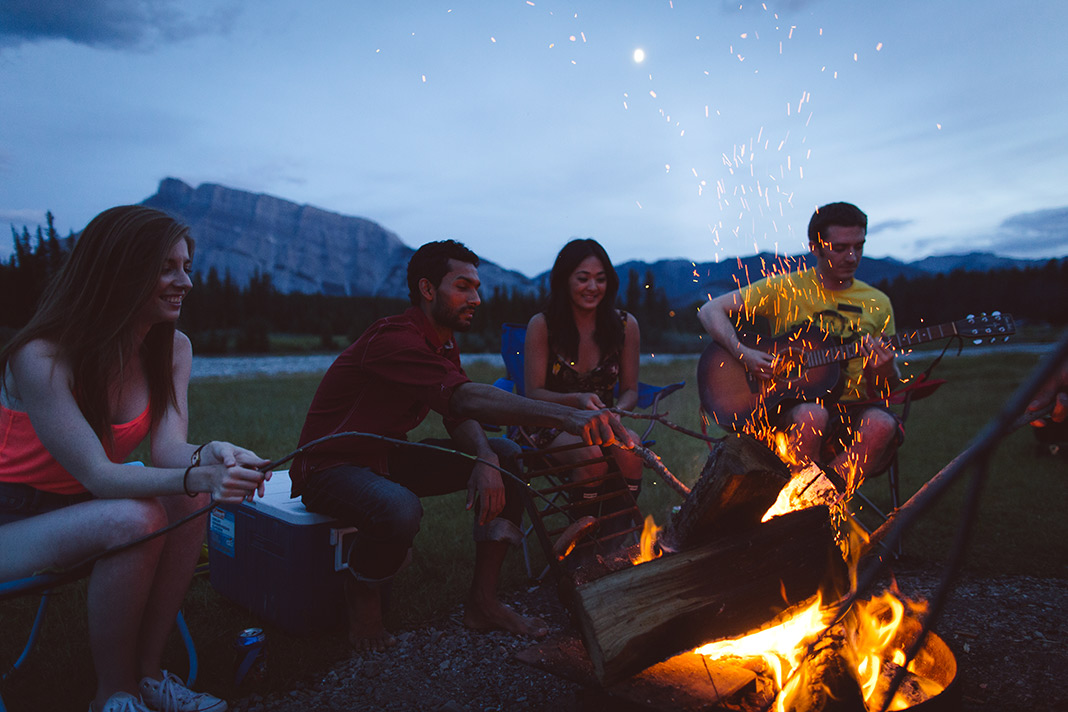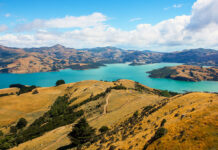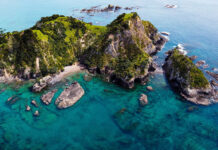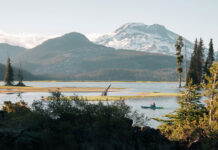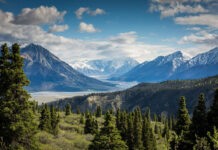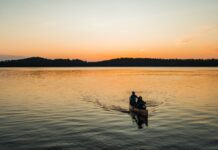Sitting on the western edges of Alberta, Banff National Park is all the superlatives of Canada crammed into one place. It’s aquamarine glacial lakes, backed by snow-capped rocky mountain peaks, set against a bluebird sky. And that’s not even making mention of the bears, elk, marmots, mountain goats and other incredible wildlife you’re likely to see on a trip here.
You could visit Banff in a day, but this is a park that deserves more than a few hours. Unfortunately, hotels in Banff tend to have prices that reflect their demand (this is the most popular park in Canada, after all), which is only part of the reason a Banff camping trip is one of the best ways to explore the region.
Whether you’re a first-time camper looking for a glampsite, a family researching the best camping around Banff, or an experienced outdoors person who is looking for a paddle-in backcountry site, we’ve got you covered. Here’s our comprehensive Banff camping guide.
[This article is part of our Ultimate Outdoor Adventurer’s Guide To Banff. Find all the resources you need to plan an adventurous trip to Banff National Park.]
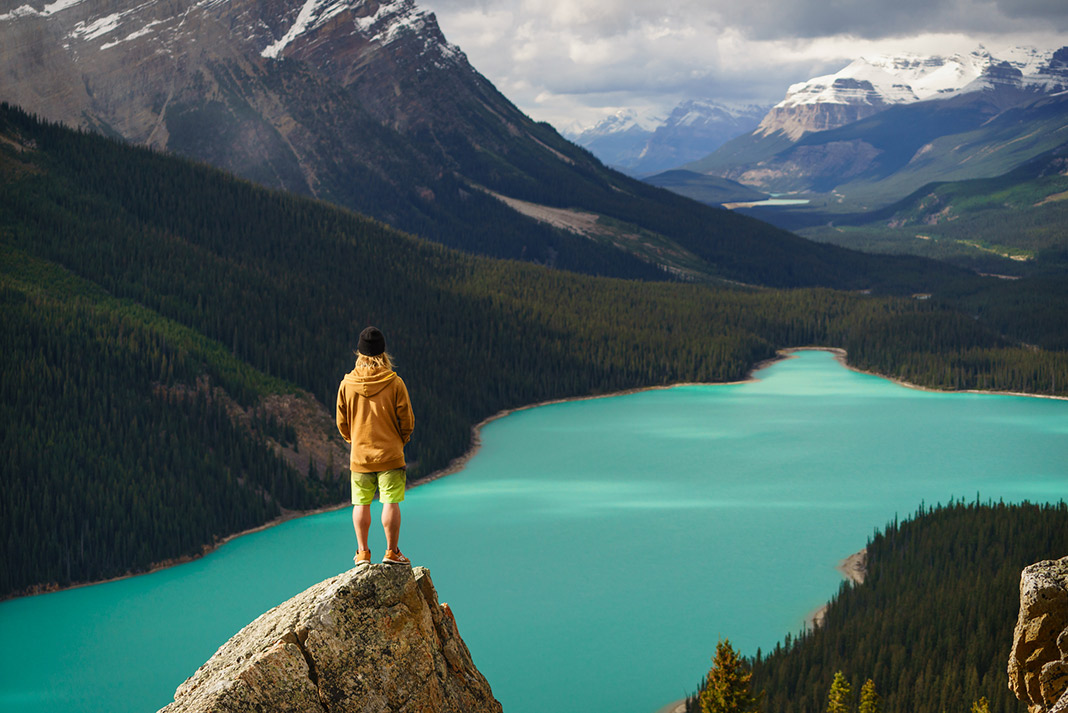
Banff campgrounds
Banff National Park‘s campgrounds are managed by Parks Canada, which operates 13 frontcountry camping areas with a total of nearly 2,500 sites available for tents and motorhomes.
The seven main campgrounds are within a short drive of the Banff townsite, but additional campgrounds exist closer to Lake Louise and along the Icefields Parkway. Most Parks Canada campgrounds in Banff are only open from May until the beginning of October, although some are open year-round.
Here are some of the most popular places to camp near Banff.
Tunnel Mountain campgrounds
If you want to be close to Banff’s townsite, then make a reservation at one of the Tunnel Mountain campgrounds. These three campgrounds are the biggest in the national park and offer some of the best camping in Banff, with a total of 1,149 sites. You won’t get much privacy, but you will have every amenity you could possibly need.
Tunnel Mountain Village II (209 sites for $33.01 CAD per night) hosts evening programs with park interpreters, while Tunnel Mountain Trailer Court (322 sites for $39.04 CAD per night) can accommodate RV’s up to 50 feet in length.
Meanwhile, Tunnel Mountain Village I ($28 CAD per night) is the largest campground in the national park, with 618 sites and an evening theater program six nights a week during the summer months. All three must be reserved online in advance.
Johnston Canyon campground
Centrally located along the Bow Valley Parkway, the Johnston Canyon campground provides the best access to the waterfalls and walkways of Johnston Canyon. It has 132 sites for small RV’s (up to 27 feet) and tents, and much like the other Banff campgrounds on this list, can even be accessed via public transportation from Banff. Make a reservation in advance to secure your spot for $28 CAD per night.
Castle Mountain campground
With just 43 sites, this is one of Banff’s smallest and most intimate frontcountry campgrounds. On the more rustic side of things, it’s in a fully wooded area about 30 minutes from town, and has limited amenities (there are flush toilets, but no showers and there’s no electrical hook-up available). As such, it’s most suitable for those in tents or camper vans. The campground fills up on a first-come, first-serve basis and payment ($21.97 CAD per night) can be made by self-registration.
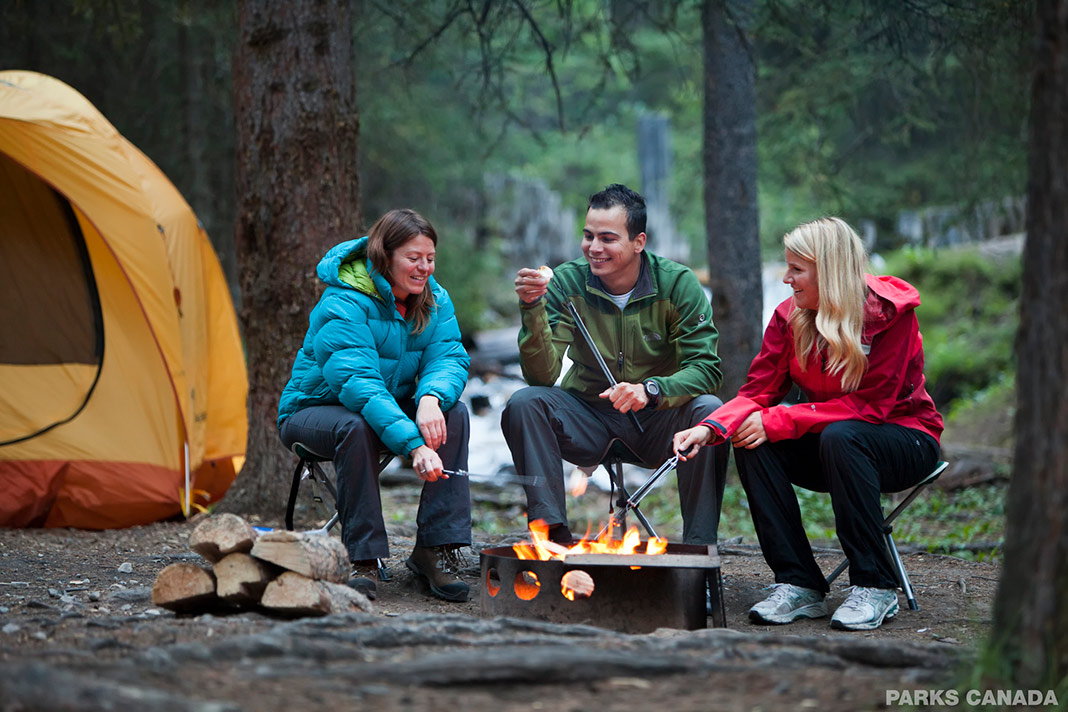
Two Jack campgrounds
Two Jack Lake has two campgrounds, with a total of 454 sites. The Two Jack Lakeside campground is one of your best options for lakeside camping in Banff, as it offers direct water access to tenters and small RVs. It’s also where you’ll find 10 oTENTiks—Parks Canada’s walled shelters. This makes it arguably the best camping in the Banff area. Regular sites cost $28 CAD per night.
The Two Jack Main campground is a bit more secluded, and just minutes from Lake Minnewanka. Sites at both campgrounds must be reserved online in advance, but be prepared for just the basics when it comes to amenities—there is no electrical service at either campground (although there is a sanitation dump at Two Jack Main), and Two Jack Main doesn’t have showers. Sites at Two Jack Main cost $21.97 CAD per night.
Protection Mountain campground
Located a little farther down the Bow Valley Parkway toward Lake Louise, Protection Mountain has 72 sites that are available on a first-come, first serve basis. Once a treed area, it’s recently been opened up for safety reasons, providing even better views of the surrounding mountains. Note that there are no showers available, cell phone reception is limited, and there are some campsites where no fires are permitted. It costs $21.97 CAD per night.
Lake Louise campground
The Lake Louise campground is split into a hard-sided and soft-sided section, containing 189 and 206 sites respectively. As the name suggests, the hard-sided campground is reserved for hard-sided camping units. It contains double sites with electrical service, only some of which have fire rings. There is a sanitation dump on-site, as well as flush toilets and showers. Campsites cost $33.01 CAD per night.
The soft-sided campground is reserved for tents, soft-sided trailers and camping equipment with soft-sided pop-outs. It’s completely surrounded by an electric fence for the safety of campers due to seasonal bear activity in the area. There are flush toilets, showers and a sanitation dump on-site, but there is no electrical hook-up. Campsites cost $28 CAD per night.
Reservations for both sections of the Lake Louise campground can be made in advance.
Mosquito Creek campground
Don’t let the name alarm you—the skeeters are no worse here than they are elsewhere in the park. Located about an hour north of Banff on the Icefields Parkway, Mosquito Creek is a first-come, first-serve campground and is among the park’s most basic. There is no cell phone coverage, nor are there flush toilets or showers, although there are an outhouses. The campground contains 32 sites, which costs $17.99 CAD per night.
Waterfowl Lakes campground
The Waterfowl Lakes campround is nearly at the border of Banff National Park and Jasper National Park, about 90 minutes northwest of the Banff township. Located on the edge of a series of small lakes along the Icefields Parkway, it contains 116 first-come, first-serve sites, flush toilets, firepits and a sanitation dump—but no has cell phone service or showers. Sites cost $21.97 CAD per night.
Rampart Creek campground
One of the most northerly campgrounds within Banff National Park, Rampart Creek is a short drive away from Saskatchewan River Crossing, where the North Saskatchewan, Howse and Mistaya rivers meet. Campsites must be reserved in advance for $17.99 CAD per night. The campground is best suited for tent campers and smaller trailers, as amenities such as flush toilets, showers, electrical hook-up and sanitation dump are not available. There’s also no cell phone service here and fire permits must be purchased at the campground.
Silverhorn Creek campground
Located 50 km north of Lake Louise, Silverhorn Creek campground has the most limited amenities of any in national park. While other campgrounds at least have running water and picnic shelters, neither are available here, no are there flush toilets, showers or options for electrical hook-up. Instead you’ll find fire rings and outhouses.
Sites are big enough to accommodate large trailers and motorhomes, however, and tenters of course are also welcome. The 45 campsites here are available on a first-come, first-serve basis and cost $16.05 CAD per night.
Banff backcountry camping
As Canada’s most popular national park, Banff receives millions of visitors per year. The result is that frontcountry camping in Banff can be incredibly busy during the summer months, making it hard to be at one with nature.
The good news is that there’s 6,641 km² of wilderness to explore. Banff’s extensive backcountry hiking system makes it easy to immerse yourself in remote natural environments.
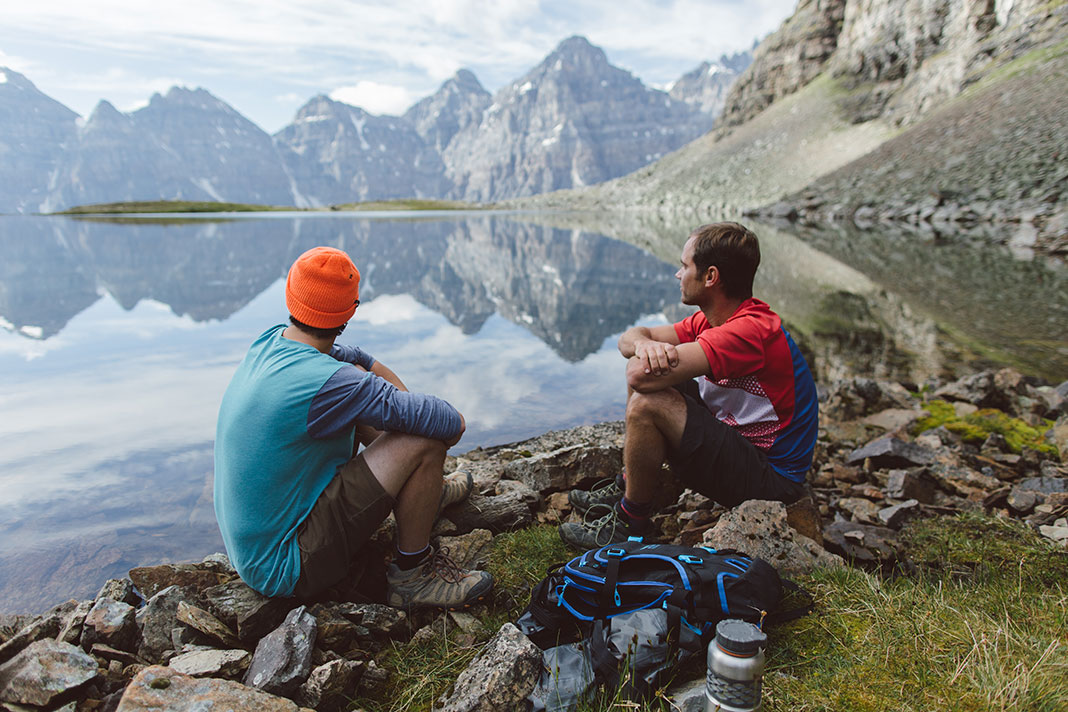
So, are you ready to go wild camping in Banff? If so, there are over 50 backcountry campgrounds spread across the park, all of which have pit toilets and food lockers. Many have fire rings—fires are not permitted at campgrounds where fire rings are not present. Almost all the backcountry campgrounds have hike-in access, but paddlers will love the six canoe-in campgrounds in the Lake Minnewanka Area and the one canoe-in campground in the Cascades/Sawback Area (this one is located on the Bow River and is the only backcountry campground that can only be accessed from the water).
Most of the backcountry campgrounds have five to 10 sites available, so reservations are highly recommended for the summer months. Likewise, rustic shelters at Bryant Creek and Egypt Lake ($6.95 CAD per night) can be booked online in advance.
Random camping is only permitted in designated areas. Pick a place to pitch your tent somewhere that’s 5 km or more from either the trailhead or any designated campground, 50 m from the trail and 70 m from the nearest water source.
Regardless of whether you choose to camp at a designated backcountry campground or designated random camping area, you’ll need to purchase a backcountry camping permit ($10.02 CAD per night). These are mandatory and can be obtained in-person at the Parks Canada Visitor Centres in Banff and Lake Louise, or by calling (403) 762-1556 in Banff or (403) 522-1264 in Lake Louise.
Campers are only permitted to stay on backcountry campsites for a maximum of three consecutive days and group sizes are a maximum of 10 people and five tents.
For trips itineraries and more information on the best backcountry camping in Banff, visit pc.gc.ca/banff-backcountry or download the brochure “Backcountry Trails in Banff National Park,” which has a Banff backcountry camping map and full list of sites.
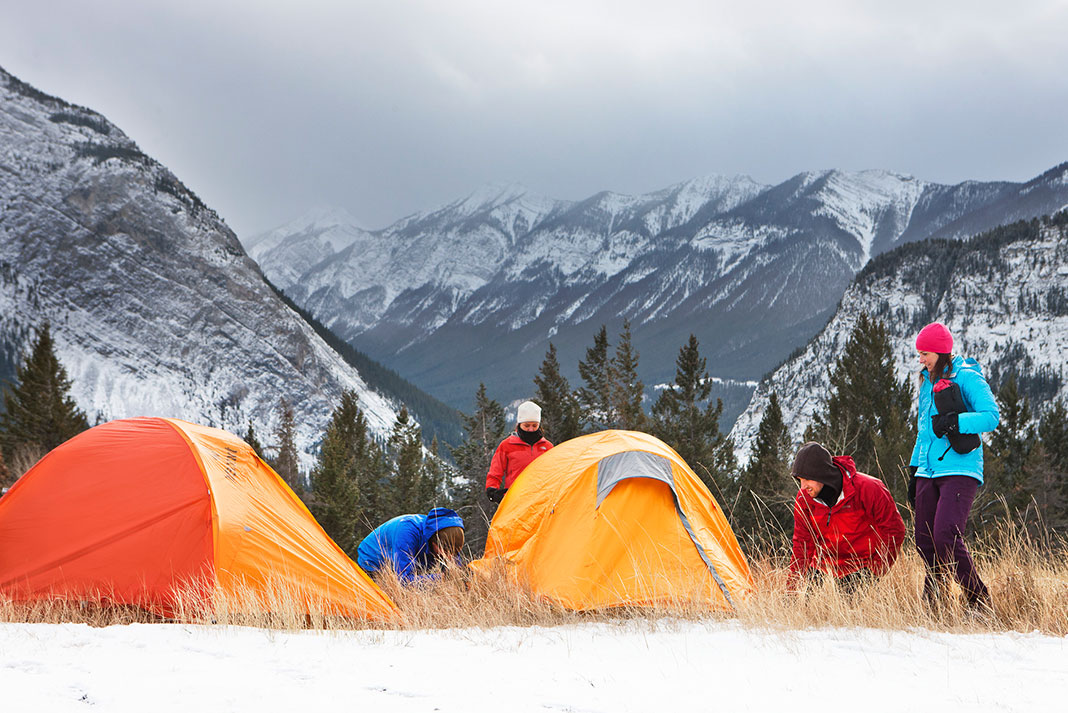
Winter camping Banff
Banff National Park may be a ski and snowboard mecca during the winter months, but that doesn’t mean camping comes to a halt.
For frontcountry wintertime camping, the Tunnel Mountain Village II campground is open year-round. Recreational vehicles and tents are both welcome and there’s no need to worry about getting cold—you’ll be able to keep warm with all the activities on offer at the neighboring Tunnel Mountain Trailer Court campground, including cross-country skiing, fat biking and snowshoeing. Down the road, the hard-sided section of the Lake Louise campground is also open year-round.
Banff’s backcountry system of campgrounds is also open year-round, but be aware there is an avalanche risk and no cell phone coverage, so you must be well-prepared for these excursions.
Luxury camping Banff
Two Jack Lake oTENTiks
A cross between an A-frame cabin and a canvas tent, the oTENTiks at the Two Jack Lakeside campground are Parks Canada’s answer to glamping. The structures have two queen-sized beds and one double bed. Reservations are recommended for these glampsites, which cost $122.64 CAD per night and book out months in advance.
Sundance Lodges
Located in nearby Kananaskis Country, Sundance Lodges offers trapper’s tents and tipis, complete with wood bed frames and mattresses. You’ll be comfortable and warm inside these upgraded tents, while still being able to enjoy the sound of rain on canvas and fresh air. Tipis and tents start at $79.50 CAD per night and can be booked at online, although two-night minimums may apply during the high season.
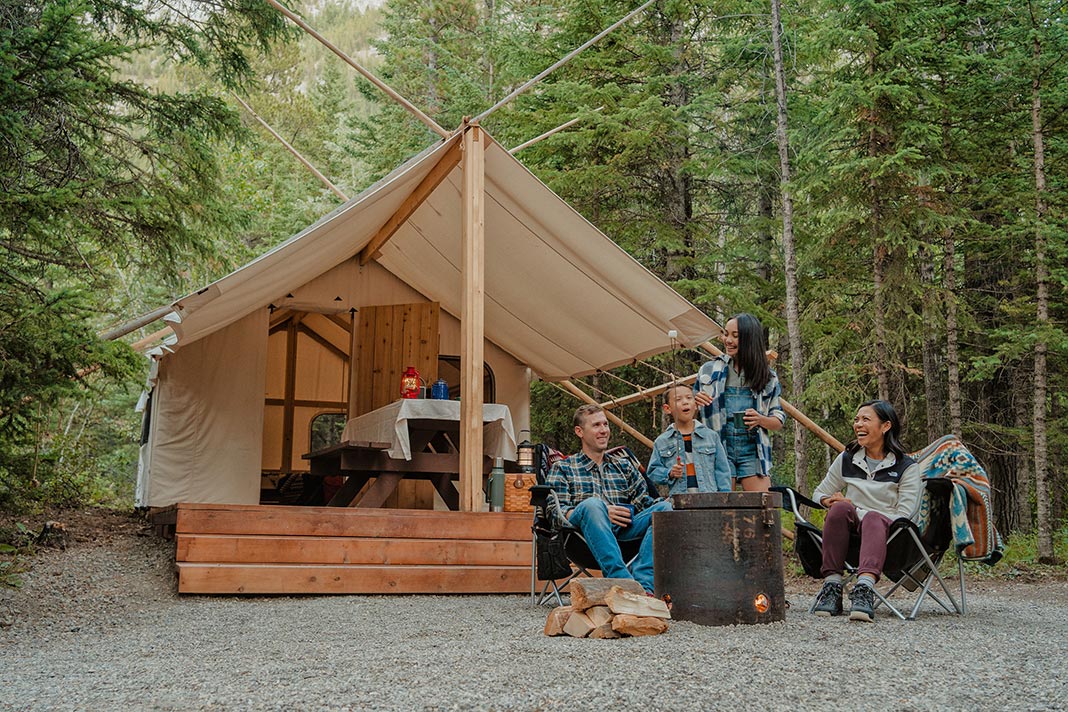
Elevated Escapes
One of the most luxurious glamping options in the Banff area, Elevated Escapes in Canmore has four themed belle tents with all the bells (get it?) and whistles. Upon request, they’ll even decorate the tent with rose petals and throw in a bottle of champagne. The tents start at $150 CAD per night.
Camping near Banff for free
During the COVID-19 pandemic, the popularity of camping on crown land exploded in Alberta. Although there is no crown land camping directly in the national park, you’re permitted to camp in “random” backcountry spots—provided they’re designated and you have a permit in-hand. (See above for more information on backcountry camping in Banff.)
There are, however, some crown land areas just outside the national park boundaries, particularly in Kananaskis. For a full rundown of free camping in Alberta and Public Land Use Zones (PLUZ), Road Trip Alberta has produced a comprehensive guide, which includes recommendations for sites near the Rockies.
If you do decide to crown land camp, please practice Leave No Trace principles and be respectful of the area you are choosing to pitch your tent or park your trailer for the night.
Banff camping opening dates
Most Parks Canada campgrounds in Banff are open from May until the beginning of October, with the busiest months being July and August. If you plan on visiting during the summer months, you’ll want to reserve your site well in advance. However, a handful of sites operate on a first-come, first-serve basis, with turnover happening around 11 a.m.
See the section above for information about year-round campgrounds in the park.
Banff camping reservations
While some of Banff’s frontcountry campgrounds are first-come, first-serve, many allow you to book sites in advance of your visit. Reserving campsites at these campgrounds is recommended, as they tend to be busy particularly during the summer months. You can do so online or by phone (1-877-737-3783).
You must make a reservation for all of Banff’s backcountry campgrounds. Purchase your permit online or by calling 1-877-737-3783.
For random camping, you must purchase a permit in-person at the Parks Canada Visitor Centres in Banff or Lake Louise, or by calling (403) 762-1556 in Banff or (403) 522-1264 in Lake Louise.
Banff camping without reservations
If you’ve arrived in Banff without a reservation during the months of July and August, you’re likely going to be out of luck. Your best option is to drive to nearby Canmore or Kananaskis to see if any campsites have availability in those areas, or camp near Calgary and plan a day trip into Banff.
Banff camping fees
Parks Canada campsites in Banff are affordably priced, ranging from $16.05 CAD for a basic site to $39.04 CAD for sites with power hook-ups.
Backcountry campground and free camping permits cost $10.02 CAD per person. There’s also a non-refundable reservation fee of $11.50 CAD when you book online and $13.50 CAD when you book over the phone.
Regardless of what type of site you choose, you’ll need to pay your national park entry fee ($10 CAD per day for adults, $8.40 CAD for seniors, $20 CAD for families and groups). This fee is not included in your camping fees.
If you’d like to have a campfire in one of the designated fire rings, fire permits ($8.80 CAD per day) are also available when you reserve your site or at camping kiosks. This also gives you access to firewood supplies at frontcountry campgrounds.
Finally, if you want to fish, you’ll need to apply for an additional permit ($9.80 CAD per day).
Banff camping supplies
Banff camping stores
Take a stroll down Banff Ave in downtown Banff, and you’ll see store after store with all of your camping and outdoor supply needs. From big outfitters like Atmosphere to high-end brands like Smartwool, Patagonia and Fjällräven, they’re all here. However, the stores are heavy on apparel and ski gear.
To avoid steep tourist prices and get better selection, it’s best to arrive fully equipped. Calgary has a wide range of big box camping stores, including Mountain Equipment Co-op.
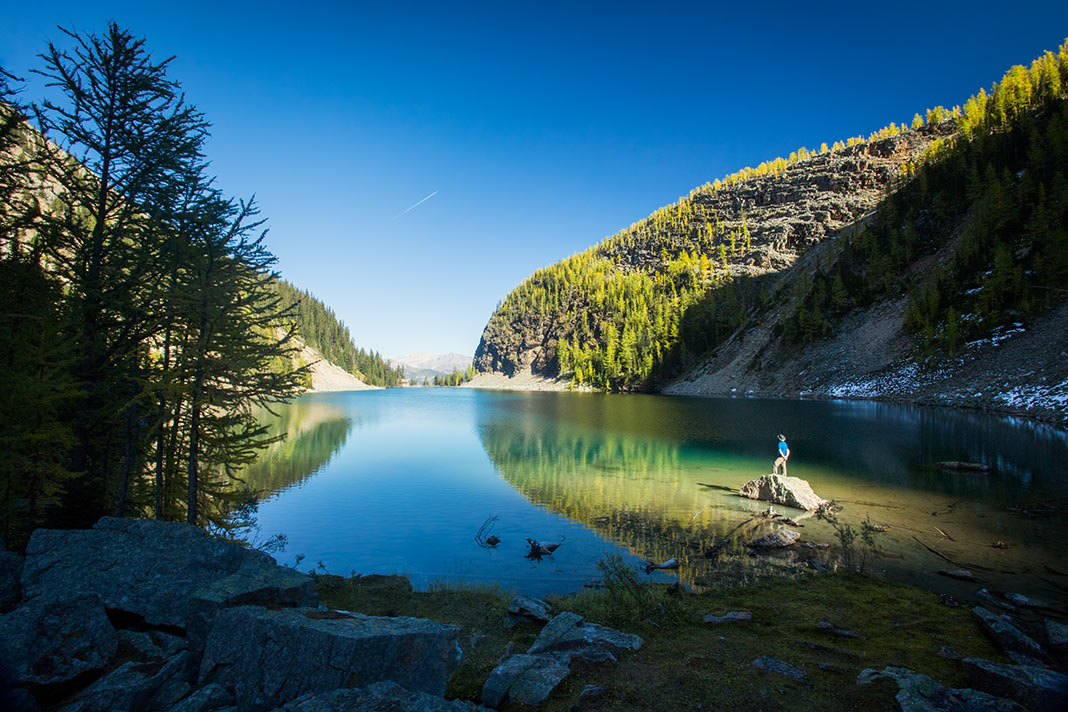
Camping rentals in Banff
Bactrax
This is arguably the best place to go in Banff for camping equipment rentals. Located at 225 Bear Street, Backtrax offers individual camping items for rent, along with its car camping packages, which set you up with everything you might need.
Rent-a-Tent
Located in nearby Canmore, Rent-a-Tent has far more than just tents. This outfitter specializes in total camping packages, which include sleeping bags, tents and all your cooking gear. One-off gear rentals and add-ons are also available.
Banff camping rules
Looking for Banff camping tips? Here’s what else you need to know about how to camp in Banff.
- Each Parks Canada campsite can accommodate six people (including children).
- You must check out of your campsite or re-register by 11 a.m. The maximum stay per campsite is 14 nights for frontcountry camping.
- Practice the Leave No Trace principles at your campsite. Tents and vehicles should only be on gravel pads (not vegetation) and you shouldn’t tie anything to the surrounding trees.
- Ready to crack open a beer? Not so fast. During long weekends, visitors to Parks Canada campsites are not permitted to possess or consume alcohol or cannabis products.
- In the Rocky Mountains, the focus tends to be on bear-proofing your campsite, but they’re not the only animals to be wary of. From squirrels to deer to elk, the name of the game when camping in Banff is ensuring you’re not only protecting yourself from wildlife, but also protecting wildlife from humans. Don’t feed the animals, keep your campsite clean, store food and scented products in your car, put garbage in wildlife-proof bins, keep your dog on a leash, report bear sightings, and give wild animals the space they need.
- When hiking in Banff, always carry bear spray, make lots of noise and travel in groups. For the latest trail conditions, check with Parks Canada before you set out.
Everything is made more magical in Banff. | Photo courtesy of: Jake Dyson



